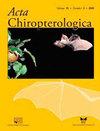秋季迁徙中转站银毛蝙蝠与非迁徙大棕蝙蝠的季节和夜间活动模式比较
IF 0.7
4区 生物学
Q4 ZOOLOGY
引用次数: 0
摘要
迁徙的温带蝙蝠要飞行数百甚至数千公里,这就需要利用中途停留点。候鸟会在中途停留的地方休息,为随后的迁徙飞行补充能量,但蝙蝠在相对短暂的中途停留期间做些什么还不清楚。本文采用声学监测的方法,比较了在加拿大安大略省Long Point迁徙的银毛蝙蝠(Lasionycteris noctivagans)和居住的大棕蝙蝠(Eptesicus fuscus)的活动模式。从2020年9月1日到10月31日,我们记录了4333次来自两个焦点物种的回声定位,并在这些记录中记录了合格的喂食蜂鸣声。夜蛾的迁徙分两波进行,其中一波已被先前的研究确定,另一波表明迁徙期可能比先前确定的要长。夜蛾的活动模式与夜蛾相似,夜蛾在黄昏和黎明都有活动和觅食,但在半夜也有活动。我们的声学监测数据补充了先前从蝙蝠捕获和无线电遥测中收集的数据,以进一步了解温带迁徙蝙蝠的中途停留行为和生态。本文章由计算机程序翻译,如有差异,请以英文原文为准。
Seasonal and Nightly Activity Patterns of Migrating Silver-Haired Bats (Lasionycteris noctivagans) Compared to Non-Migrating Big Brown Bats (Eptesicus fuscus) at a Fall Migration Stopover Site
Migrating temperate bats travel hundreds and perhaps thousands of kilometers, which necessitates making use of stopover sites. Migratory birds use stopover sites to rest and refuel for subsequent migratory flights, but it isn't clear what bats do during their comparatively brief stopovers. We used acoustic monitoring to compare activity patterns of migrating silver-haired bats (Lasionycteris noctivagans) and resident big brown bats (Eptesicus fuscus) at Long Point, Ontario, Canada. From September 1 to October 31 2020 we recorded 4,333 echolocation passes from our two focal species and quatified feeding buzzes in those recordings. Migratory L. noctivagans passed through in two waves, one of which had been identified by previous study, and a second suggesting that the migratory period may be longer than previously identified. Eptesicus fuscus was primarily active only in the early and late parts of the night, in contrast to the activity pattern of L. noctivagans which were similarly active and foraging at dusk and dawn, but also during the middle parts of the night. Our acoustic monitoring data complement previous data collected from bat captures and radiotelemetry to provide further insight into stopover behaviors and ecology of temperate migratory bats.
求助全文
通过发布文献求助,成功后即可免费获取论文全文。
去求助
来源期刊

Acta Chiropterologica
生物-动物学
CiteScore
2.50
自引率
20.00%
发文量
42
审稿时长
>12 weeks
期刊介绍:
Acta Chiropterologica, published by the Museum and Institute of Zoology at the Polish Academy of Sciences, is devoted solely to the study and discussion of bats.
 求助内容:
求助内容: 应助结果提醒方式:
应助结果提醒方式:


